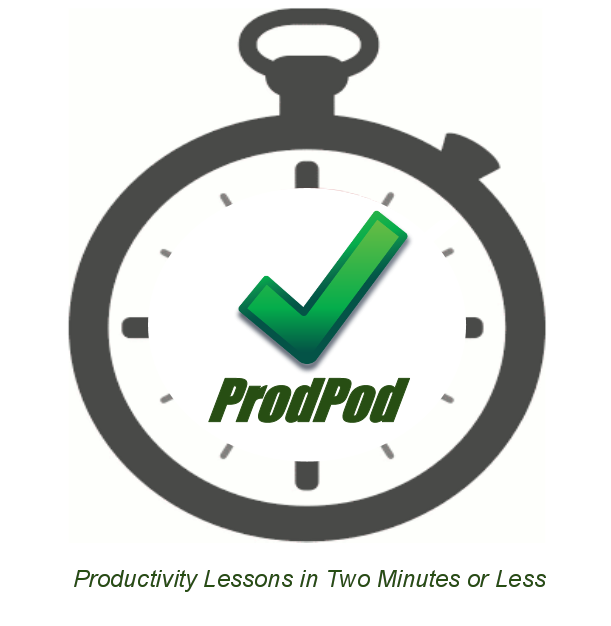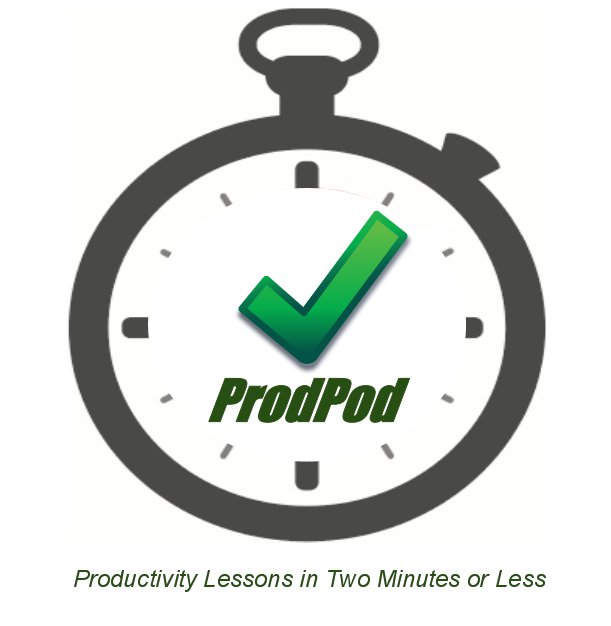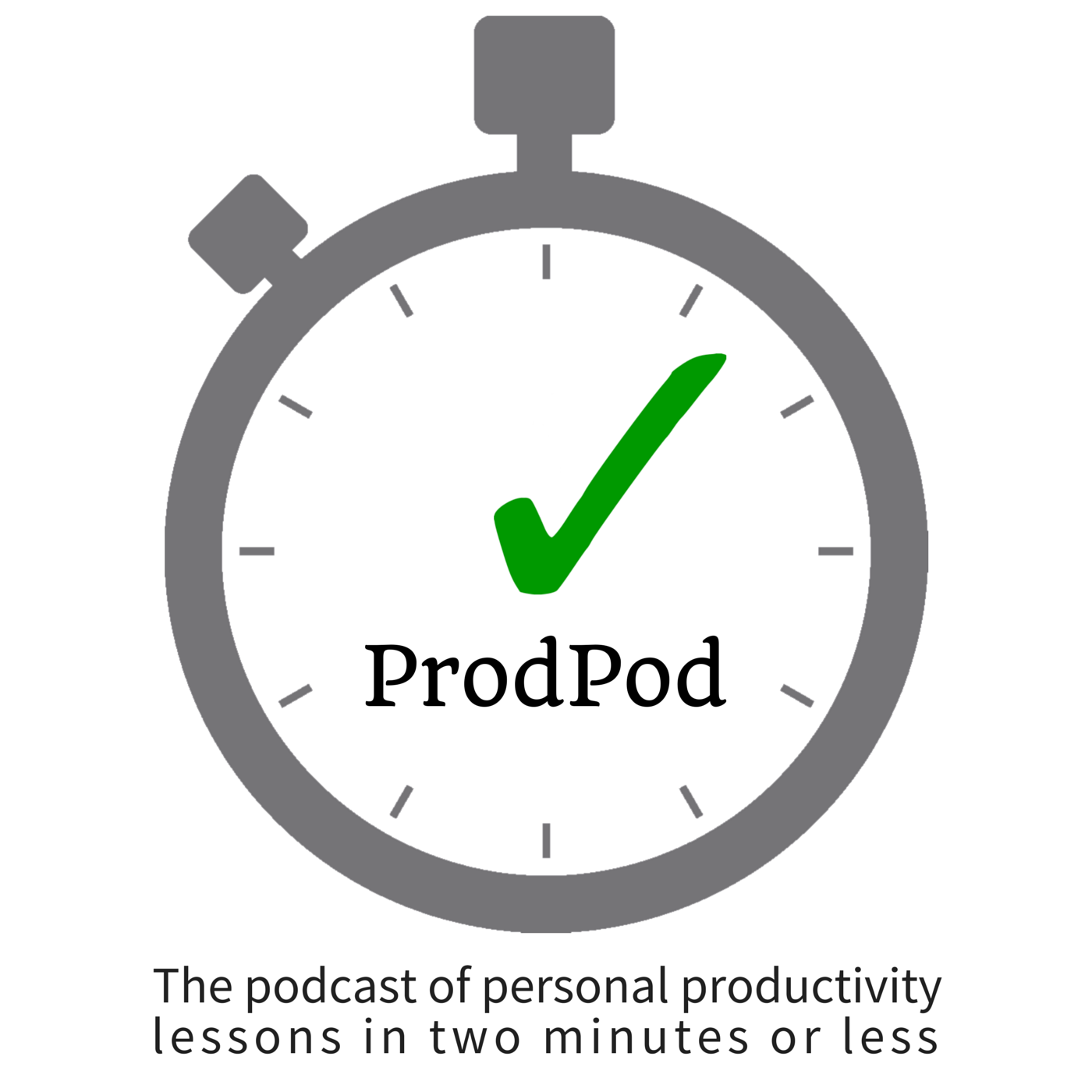Episodes

Friday Feb 22, 2013
ProdPod: Episode 56 -- Software Overview: Remember The Milk
Friday Feb 22, 2013
Friday Feb 22, 2013
Here's a quick overview of the amazing capabilities of my personal productivity software, Remember The Milk. What's your favorite personal productivity software? Let me know in the comments, contact form or via email!

Wednesday Feb 20, 2013
ProdPod: Episode 55 -- The Purpose of Your Productivity System
Wednesday Feb 20, 2013
Wednesday Feb 20, 2013
In this episode, I define "personal productivity system." How do you define your personal productivity system? I'd love to hear from you in the comments or via email.
There was a time when I started first studying psychology and its relationship to my personal productivity when I thought my "productivity system" meant automation. Boy, was I sadly mistaken! It took me a long time (18 months to be exact) to figure out that my productivity system wasn't all about automating my life. It turns out that DOING was a huge part of my productivity system, and *I* had to do the DOING. What a shock to my system this was when I spent all that time setting up this amazing system and planning all day! Nothing got done! So, what is the purpose of your productivity system? I've come to define the purpose of a personal productivity system as a way to facilitate you DOING more consistently and better and KNOWING what you're not able to DO at any given time so you can relax and focus on what it is you can do.
Let me dive into this a little further so I explain this correctly.
The first part of that definition is that your personal productivity system is about doing more and better when you're able to. Doing more means, that by planning out the most efficient ways to get from A to B for any given task or project, you're able to get more done in a focused period of time. This isn't something you can do consistently without a system; believe me, for years, I tried! Next up is the adjective "better." What I mean is, that your productivity system should have a way for you to track what you've done and review what has been done to create as accurate a historical record as possible. Therefore you can match or increase your output sustainably from there. Again, no system equates to not only allowing in subjectivity about "better" but also about using potentially your fuzzy memory to recollect what you accomplished, or didn't. What does better look like for you?
Finally, one of the great, rarely spoken truths about personal productivity is the fact that you can't do more of anything without doing less of something right now. Your productivity system needs to be able to help you track when you can do things and when you cannot. Do you know what you can't do right now so you can start doing the one thing now that you can? If so, you likely have a system. If you don't, now you know why you need a system, and what a system really is.
How do you define "personal productivity system?" I'd love to hear from you in the comments or via email.

Thursday Feb 14, 2013
ProdPod: Episode 54 -- "Pull Method" for More Productive Relationships, Part Two
Thursday Feb 14, 2013
Thursday Feb 14, 2013
In the last episode, I discuss why I developed a "pull method" for more productive relationships along with the first phase. In this episode, I'll cover the next two phases.
2. Now that you have your relationships list, go down the list and mark each person with symbols representing whether you feel good or not when they come into mind. I use + or - signs, or :-) :-| or :-( , for my symbols. Not good includes however you define it but typically encompasses for me annoyance, frustration, indifference and dislike. Follow that exercise with placing an asterisk next to contacts with whom you must have a relationship. Perhaps I'll explain my thoughts on how I perform this data collection and analyze this data on a more granular level in a future episode. Some thoughts to ponder: what is the ratio of must relationships to positive symbol ones? Are there more not-good than feel-good contacts on your list? Does the happiness of the people you listed correlate to your relative happiness in life?
3. Moving onto the final phase of the pull method, take your list and filter to two new lists: one for your feel-good's and one for your not-good but must-have relationships. Now, for your feel-good's, plan ways in which you can see those people more (yes, in real life), deepen your relationships and generally show your appreciation for having them in your life...ergo, pull them closer to you! For the must-have's, put together a plan to increase positive interactions and carefully but steadily address the aspects of these relationships that make it not-good. Remember, some of these things that you don't like in your must-have relationships are likely present in your feel-good relationships as well; I'd start with confronting the issues in the not-good must-have relationships before backtracking to those of the feel-good's.
There you have it! The pull method for more productive relationships.

Tuesday Feb 12, 2013
ProdPod: Episode 53 - "Pull Method" for More Productive Relationships, Part One
Tuesday Feb 12, 2013
Tuesday Feb 12, 2013
In this episode, I introduce you to my relationships management technique I call the "pull method" and explain the first of three phases. In episode 54, I continue with phases two and three of the pull method. Enjoy!
The human mind can keep approximately 150 social connections in their conscious mind at any given time. This median average comes from Dunbar's number named after the British anthropologist, Robin Dunbar, who theorized the oft-cited social metric. I have thousands of people that think they "know" me because they've connected with me in some light touchpoint manner at countless business and social events, hundreds of seminars and presentations I've spoken at, email messages and via Social Media. I'm truly blessed to be able to communicate with some really great people in my professional and personal lives all over the world, and I honor and appreciate every communication I have in my life. However, these online platforms create sometimes a false perception of relationship and genuine community and I want to make sure I'm fostering healthy, productive relationships with the people I truly care about and want to get to know better. So for several years, I've developed a technique to keep myself from being overwhelmed by the overconnectedness of social networking services like Facebook, Twitter and LinkedIn.
I call this technique, the "Pull Method." Here are the basics:
1. First, make an accounting of the people you care about. On a piece of paper with pen (that is, without any address books or electronic aids), wrote down everyone important in your life today; broadly, the categories are family, social and professional connections. Number them. If there are more than 200 contacts, you should likely review the list to *really * consider whether you care about these people or that you just remembered them. Note, this isn't a memory challenge but a practice in determining about whom you really care. Once you've done that, you can move on to the next two phases.
In the next episode, I'll cover phases two and three of my "Pull Method" for more productive relationship. Stay tuned!

Thursday Feb 07, 2013
ProdPod: Episode 52 -- Overflowing Inbox: Try Some Email Overload Relief
Thursday Feb 07, 2013
Thursday Feb 07, 2013
An overflowing inbox is something that we have all probably experienced at some point in our personal and professional lives. Unexpected life circumstances happen and as well we sometimes get lax in our discipline to manage our email traffic on a regular basis. In this episode I give a simple strategy for managing this email overload and some email services that are handy to help manage your email from getting to that point in the first place.
Services mentioned in this episode:
- Unroll.me
- Sanebox (I get a free 5$ account credit for each person that signs up using this link.)
- Boomerang Gmail (I get some kind of credit for you signing up using this link, but I can't figure out what that is!) :-P
- Gmail Valet
The first step is to shut off the email spigot. Create a strategy for sustainably processing your inbox from today forward. Then look at your backlog and attempt to establish a breadcrumb method for dealing with the back email messages. For example, a friend and colleague of mine takes the oldest days worth of email and the last two days' email to process. Doing this every workday along with keeping up with the inbound email today is manageable and in just a few days or weeks's time, you're back to Inbox Zero.
To help with shutting off the email spigot, there's an email service called Unroll.me. It helps you unsubscribe from all those email newsletters you think you should be receiving but they're really just distractions.
Another service is called Sanebox. It automatically filters messages that you don't need to deal with right now so that you can bring those into view when you actually want to address them. I really enjoy being able to train Sanebox and seeing the statistics of how many hours it saves of my time.
Also a favorite service of mine is Boomerang Gmail. It enables you to send email out of view then come back to you at a predetermined date and time. Also Boomerang Gmail is able to schedule an outbound email and has several other really great features so check this one out, for sure.
And finally there's a new service called Gmail Valet. What I understand about the service is that there are real humans who have access to your inbox. And, as new email arrives they review your email to see whether or not it's actionable. If it is, they add it to a task list for you and otherwise move nonactionable items according to your specifications. It's currently free to use in beta!
So there you have it, a strategy for dealing with email overload and some services that can possibly help you from it getting overwhelming in the first place.

